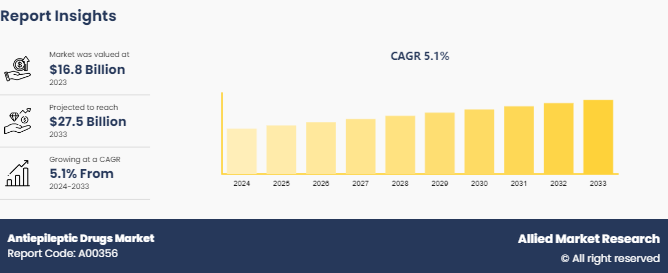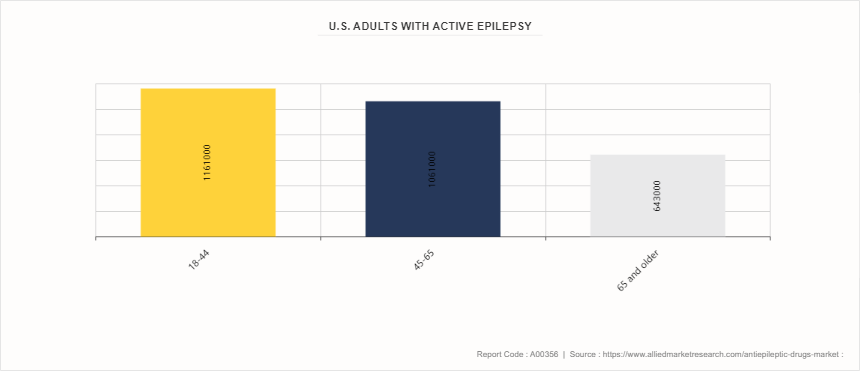Antiepileptic Drugs Market Research, 2033
Market Introduction and Definition
The global antiepileptic drugs market size was valued at $16.8 billion in 2023, and is projected to reach $27.5 billion by 2033, growing at a CAGR of 5.1% from 2024 to 2033. The major factors driving the growth of the antiepileptic drugs market are the increasing epilepsy prevalence, rising awareness and diagnosis rates, and advancements in drug development. The expanding patient pool, including both children and adults, is fueling demand for effective treatments. Innovations such as novel antiepileptic drugs formulations with improved safety profiles and targeted therapies contribute to market growth. In addition, supportive government initiatives and funding for epilepsy research, along with the growing focus on personalized medicine, further drive the antiepileptic drugs market growth.
Antiepileptic drugs are medications designed to manage and control seizures in individuals with epilepsy. These drugs work by altering the electrical activity in the brain, which can help prevent or reduce the frequency and severity of seizures. Antiepileptic drugs can be classified into various categories based on their mechanisms of action. For instance, some work by stabilizing neuronal membranes and reducing excitability, while others may enhance inhibitory neurotransmission or inhibit excitatory neurotransmission. Commonly prescribed antiepileptic drugs include phenytoin, carbamazepine, valproate, lamotrigine, and levetiracetam. The choice of medication often depends on the type of epilepsy, the patient's overall health, and potential side effects.

Key Takeaways
- The antiepileptic drugs market share study covers 20 countries. The research includes a segment analysis of each country in terms of value for the projected period.
- More than 1, 500 product literatures, industry releases, annual reports, and other such documents of major antiepileptic drugs industry participants along with authentic industry journals, trade associations' releases, and government websites have been reviewed for generating high-value industry insights.
- The study integrated high-quality data, professional opinions and analysis, and critical independent perspectives. The research approach is intended to provide a balanced view of global markets and assist stakeholders in making educated decisions to achieve their most ambitious growth objectives.
Key Market Dynamics
According to antiepileptic drugs market forecast analysis the key factors driving the growth of the market are rise in incidence of epilepsy, increasing healthcare expenditure and advancements in drug development. Epilepsy, a chronic neurological disorder characterized by recurrent seizures, affects millions of people worldwide. According to a 2024 article by the World Health Organization, epilepsy is the most common chronic brain disease and affects people of all ages. More than 50 million people worldwide have epilepsy. The increasing prevalence of epilepsy can be attributed to various factors, including improved diagnostic capabilities, a greater awareness of the condition, and an aging population. As more individuals are diagnosed with epilepsy, the demand for effective antiepileptic medications rises. Thus, the rise in prevalence of the epilepsy is expected to drive antiepileptic drugs market growth.
According to antiepileptic drugs market analysis increasing healthcare expenditure and advancements in healthcare infrastructure is expected to drive the growth of the market. Rising healthcare budgets globally have led to improved access to medical care and more resources allocated towards the treatment of neurological disorders, including epilepsy. In addition, funding initiatives for medication and health checkup of epilepsy patients by government and private organizations also contribute to market growth. For instance, Epilepsy Foundation of India adopt a patient initiative in which the organization collects donation for medication of the epilepsy patient. In addition, Epilepsy Foundation of India also organize awareness camps in rural parts of India. Thus, factors such as an increase in healthcare expenditure and advancements in healthcare infrastructure are expected to drive the growth of the antiepileptic drugs market size.
Furthermore, advancements in drug development have significantly contributed to the growth of the antiepileptic drugs (AEDs) market. Recent innovations in pharmaceutical research have led to the discovery and introduction of novel AEDs with improved efficacy and safety profiles. This includes the development of targeted therapies that address specific subtypes of epilepsy, offering more personalized treatment options for patients. In February 2021, Dr. Reddy's Laboratories launched Vigabatrin tablets, an antiepileptic drug, in the United States market after receiving approval from the United States Food and Drug Administration. In addition, advancements in drug delivery systems and formulations have enhanced the bioavailability and patient compliance of AEDs. Breakthroughs in genomics and biomarker research have facilitated a better understanding of epilepsy’s underlying mechanisms, enabling the design of drugs that can more effectively modulate the neural pathways involved. Thus, the new drug development is expected to drive the growth of the market.
Growing Prevalence of Ophthalmic Disorders
The rise in the incidence of epilepsy is a significant driver for the antiepileptic drugs (AEDs) market. Epilepsy, a neurological disorder characterized by recurrent seizures, is increasingly being recognized as a major health concern globally. The growing prevalence of epilepsy is attributed to various factors, including improved diagnostic capabilities, increased awareness, and a better understanding of the condition, which have led to more cases being identified and reported. This rising incidence drives demand for effective treatment options, thereby propelling the antiepileptic drugs market. AEDs are essential for managing epilepsy, as they help in controlling seizures and improving the quality of life for patients. As the number of individuals diagnosed with epilepsy continues to grow, there is a heightened need for innovative and effective medications to address different types of seizures and epilepsy syndromes.

Market Segmentation
The antiepileptic drugs industry is segmented into drug, route of administration, distribution channel, and region. By drug, the market is classified into first generation, second generation, third generation. By route of administration, the market is divided into oral, and intravenous. By distribution channel, it is segregated into hospital pharmacies, retail pharmacies, online pharmacies, and drug stores. Region wise, the market is analyzed across North America, Europe, Asia-Pacific, and LAMEA.
Regional/Country Market Outlook
North America dominated the antiepileptic drugs market share in 2023. This is attributed to advanced healthcare facilities with state-of-the-art technology, high prevalence of epilepsy, and strong presence of major key players. However, according to antiepileptic drugs market opportunity analysis, the Asia-Pacific region is expected to register significant growth in the forecast period owing to rise in geriatric population and growth in healthcare infrastructure.
- According to 2024 article by Center of Disease Control and Prevention, almost 3 million U.S. adults have epilepsy.
- According to an article by Center of Disease Control and Prevention, in 2021, about 2.9 million U.S. adults 18 and older reported having active epilepsy.
- According to 2023 article by Sanofi, in India, epilepsy is a significant health concern, with an estimated prevalence of around 1% to 2% percent of the population.
Industry Trends
- According to 2024 article by World Health Organization around 50 million people worldwide have epilepsy, making it one of the most common neurological diseases globally.
- According to the 2024 article by Epilepsy Research Institute UK, 1 in 103 people in the UK have epilepsy.
- According to 2022 article by World Health Organization, 1 in every 8 people in the world live with a mental disorder.
- According to 2023 article by World Health Organization, more than 50 million people worldwide have epilepsy; nearly 80% of them live in low- and middle-income countries.
Competitive Landscape
The major players operating in the Antiepileptic Drugs market include Johnson & Johnson, Merck KGaA, Eisai Co., Ltd., AstraZeneca, Novartis AG, Abbott, Teva Pharmaceutical Industries Ltd., Pfizer Inc., GlaxoSmithKline plc, and Sanofi.
Recent Key Strategies and Developments
- In March 2024, The United States Food and Drug Administration approved Epidiolex, a cannabis-derived drug, for the treatment of epilepsy in neurology at Children's Hospital of Philadelphia.
- In July 2023, SK Biopharmaceuticals, a South Korean company, received approval in Canada to sell its new epilepsy drug, Cenobamate, under the product name Xcopri, aiming to expand sales in the country.
- In January 2023, IAMA Therapeutics and PsychoGenics collaborated to study the efficacy of novel drug candidates in pre-clinical animal models of Dravet syndrome, a rare childhood epilepsy causing significant life-threatening complications.
Key Benefits for Stakeholders
- This report provides a quantitative analysis of the market segments, current trends, estimations, and dynamics of the antiepileptic drugs market analysis from 2024 to 2033 to identify the prevailing antiepileptic drugs market opportunities.
- The market research is offered along with information related to key drivers, restraints, and opportunities.
- Porter's five forces analysis highlights the potency of buyers and suppliers to enable stakeholders make profit-oriented business decisions and strengthen their supplier-buyer network.
- In-depth analysis of the antiepileptic drugs market segmentation assists to determine the prevailing market opportunities.
- Major countries in each region are mapped according to their revenue contribution to the global market.
- Market player positioning facilitates benchmarking and provides a clear understanding of the present position of the market players.
- The report includes the analysis of the regional as well as global antiepileptic drugs market trends, key players, market segments, application areas, and market growth strategies.
Antiepileptic Drugs Market Report Highlights
| Aspects | Details |
| Market Size By 2033 | USD 27.5 Billion |
| Growth Rate | CAGR of 5.1% |
| Forecast period | 2024 - 2033 |
| Report Pages | 280 |
| By Drug |
|
| By Route Of Administration |
|
| By Distribution Channel |
|
| By Region |
|
| Key Market Players | AstraZeneca, Eisai Co., Ltd., Teva Pharmaceutical Industries Ltd., Sanofi, Pfizer Inc., GlaxoSmithKline Plc, Merck KGaA, Abbott Laboratories, Johnson & Johnson, Novartis AG |
The global antiepileptic drugs market was valued at $16.8 billion in 2023
The market value of Antiepileptic Drugs Market is projected to reach $27.5 billion by 2033.
The forecast period for Antiepileptic Drugs Market is 2024-2033.
Major key players that operate in the Antiepileptic Drugs Market are Johnson & Johnson, Merck KGaA, Eisai Co., Ltd., AstraZeneca, Novartis AG
The base year is 2023 in Antiepileptic Drugs Market
Loading Table Of Content...



